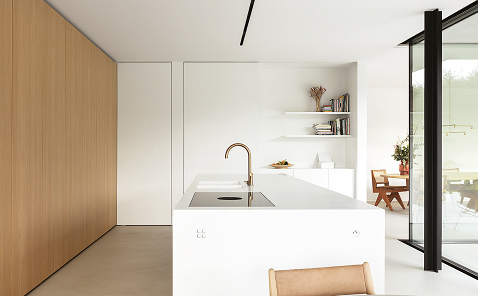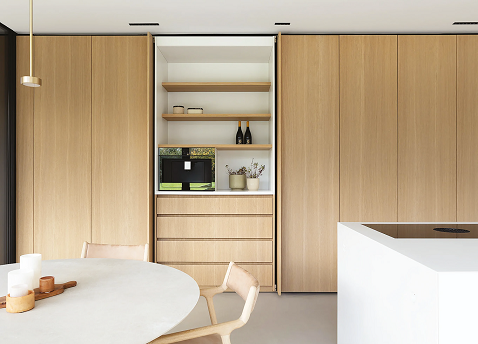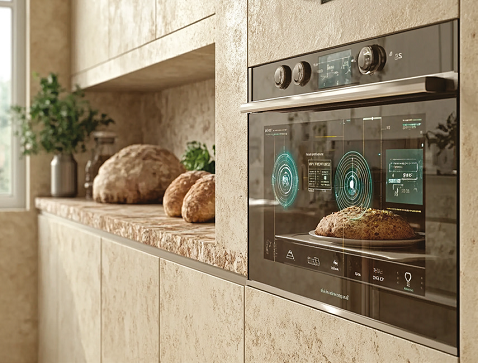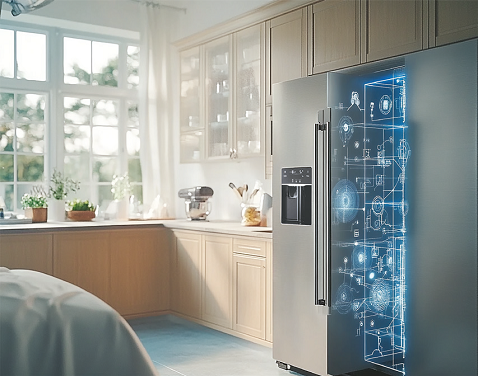Listen to the audio version of this article. Duration: 8 minutes.
The kitchen has become the new focal point of the home: efficient, connected, and versatile, where technological innovations enable appliances to function independently, adapting to the personal habits of the users. Above all, there is a strong emphasis on sustainable solutions.

The new concept of living views the home — each person’s personal microcosm — as a holistic system, guiding design towards greater refinement, efficiency, and seamless connection between the various functions of the domestic spaces. At the heart of this system, the kitchen reaffirms its central role, becoming a modern-day agora that continues to expand, where the family engages in a rich array of activities. It is a space shaped by the desire for conviviality, natural quiet, and sustainable choices that reflect the values of today’s conscious consumers. No longer confined to a secluded area for the preparation of meals, the kitchen has evolved into a multifunctional, technology-driven space, with furnishings and equipment that prioritise both versatility and eco-sustainability. The trends that emerged during the Milano Design Week 2024 reflect the key directions for the industry’s evolution. Alongside the reaffirmed centrality of the kitchen, sustainability emerged as a critical theme, with eco-conscious design taking a prominent role in the creative and design processes. Furniture made from recycled materials, technological innovations in lighting systems, and energy-efficient appliances dominated in the exhibition spaces, highlighting environments inspired by minimalism and Japandi styles, ranging from elegant to experimental. These spaces featured organic forms, natural colours, and materials, reflecting diverse tastes, lifestyles, and generational expectations. Moreover, consumers are placing their trust in companies committed to sustainable production cycles, reducing their carbon footprint, and incorporating sustainable end-of-life management into their product designs.
THE KITCHEN: fluid living, or hideaway
In terms of spatial organisation, the kitchen of the 2020s is not only hybrid and integrated, but also highly adaptable, sharing key functional elements with the living area, such as large tables, bookcases, shelving, and modular, customisable panelling systems that connect or separate rooms as needed. At the heart of this new versatility is the island, which becomes increasingly equipped and technological, featuring on-demand modularity that allows worktops to double as dining tables or spaces for smart working or study. This functional transformation also responds to a growing desire for order, cleanliness, and a shift in atmosphere, moving beyond the simple act of cooking. As a result, the kitchen can now be concealed behind engineered door systems that hide equipment, appliances, pantries, and sinks, leaving behind a minimalist island that is almost unrecognisable.
NATURE IN MATERIALS
The desire for natural, or green, environments is driving the growing demand for natural aesthetics - whether genuine or simulated - that define today’s kitchens. Materials like granite, quartz, and marble are becoming more prominent, alongside porcelain stoneware and ceramic clays, which, thanks to technological innovations, now offer ‘natural’ textures and finishes. These materials also boast exceptional qualities, such as chemical resistance, impact resistance, and UV protection, ensuring greater durability over time. Despite these trends, light-toned wood remains one of the most favoured materials for kitchen finishes. Stainless steel, on the other hand, deserves a special mention. It has become a defining feature of kitchens with a professional look, a style partly popularised by TV cooking shows and culinary talent programmes. Moreover, stainless steel meets eco-conscious expectations with its inherent sustainability. Its durability, hygiene, ease of maintenance, and 100% recyclability make it a champion of sustainable design.

SMART AND RESPONSIBLE KITCHEN APPLIANCES (Thanks to Technology)
New generation kitchen appliances, designed for cooking and food storage, are equipped with advanced technology enabling them to manage most operations on their own, and not only. The artificial intelligence integrated into ovens, refrigerators, dishwashers, and hoods allows these appliances not only to handle performance cycles independently, but also to record and process data, evolving their intelligent systems in a user-centric approach. This technology enables the appliances to adopt behaviours tailored to the specific needs of each owner.
Connectivity, now highly advanced, ensures interoperability between appliances, even those from different brands. In the smart home, the kitchen becomes a connected technological suite, easily managed via platforms and apps accessed from your mobile device or television.
The Intelligence of Household Appliances

AI-generated image
OVENS
Advanced models now automatically manage nutritionally optimal cooking. Thanks to smart algorithms, they can cook proteins and vegetables simultaneously while preserving their organoleptic and nutritional qualities, or handle precise parameters for specialised cooking methods such as baking.
INDUCTION HOBS
Smart hobs autonomously control cooking temperatures. By detecting the temperature of liquids in pots, they can adjust heat levels for perfect cooking, preventing spills, and automatically switching off when the process is complete. Some models feature screens that are integrated into the cooking surface, allowing interaction with the web via smartphones.

AI-generated image
REFRIGERATORS
These models independently regulate temperature and energy consumption. The most sophisticated refrigerators can recognise the food types, suggest recipes, and alert you when products are nearing their expiration date or running low. In some cases, they can even order groceries online. With large integrated screens encased in the doors, they transform into connected hubs, offering entertainment and social networking opportunities. Connected ovens and refrigerators will “collaborate”: the refrigerator, recognising the available ingredients, will communicate with the oven, which will suggest a range of possible recipes based on what’s in stock.
DISHWASHERS
Smart dishwashers now manage their washing cycles autonomously, choosing the correct detergent dosage and optimising wash times to ensure efficient cleaning while saving energy.
Copyright © Homa 2025
All rights reserved

.jpg?VGhlIFBlcmZlY3QgU2xvdC1pbijmraPnoa4pLmpwZw==)

































